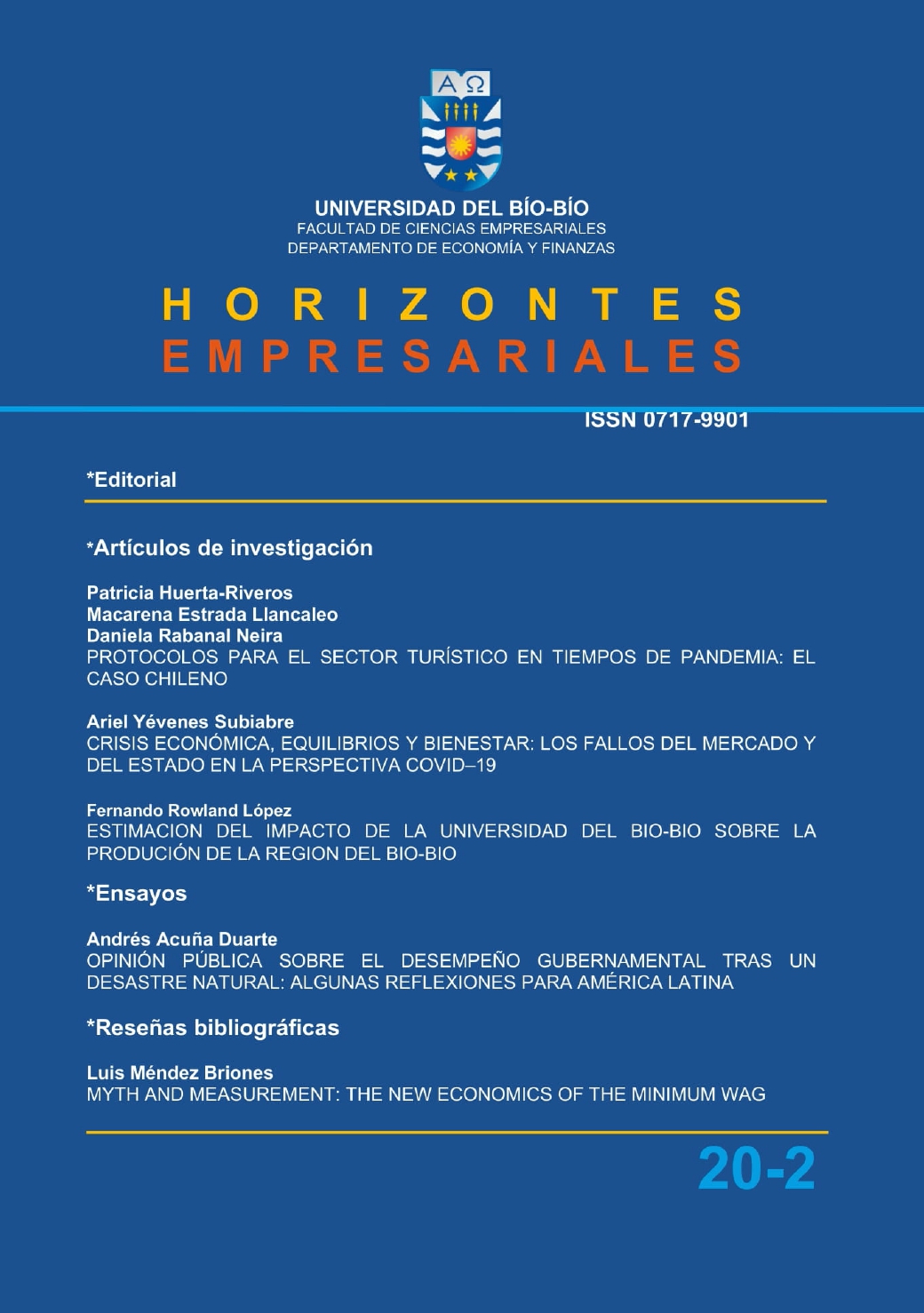Estimación del impacto de la Universidad del Bío-Bío sobre la producción de la Región del Biobío
DOI:
https://doi.org/10.22320/hem.v20i2.5176Palabras clave:
Universidad del Bío-Bío, Matriz insumo-producto, Región del BiobíoResumen
La Universidad del Bío-Bío es una institución de educación superior chilena, de carácter estatal. No hay un estudio que mida el aporte económico que haga la Universidad del Bío-Bío y sus diferentes personas relacionadas en la Región del Biobío. Por ello, utilizando una aproximación de la matriz insumo-producto de la Región del Biobíopara el año 2012 estimo el aporte que hacen al producto de la Región del Biobíola Universidad y las personas relacionadas a ella. Encuentro que la Universidad aporta a la producción de la región tanto directa como indirectamente, totalizando para el año 2020 $483.049.705.595, con lo cual luego hacemos una serie de propuestas para las autoridades de la Universidad y de la educación de la región.
Citas
Barriga, C. (2016). Aproximación de una matriz insumo-producto y análisis de los encadenamientos productivos de la Región del Biobío. Memoria para optar al grado de Magíster en Dirección de Empresa.
Batten, D. (1995). Network cities: creative urban agglomerations for the 21st century. Urban Studies, Vol. 32, No 2, pp. 313-327.
Beck, R.; Elliot, D.; Miesel, J. & Wagner, M. (1995). Economic Impact Studies of Regional Public Colleges and Universities. Growth and Change. Vol. 26 (Spring), pp. 245-260.
Blackwell, M.; Cobb, S. & Weinberg, D. (2002). The Economic Impact of Educational Institutions: Issues and Methodology. Economic Development Quarterly. Vol. 16. No. 1, February, pp. 88-95.
Brown, K. & Heaney, M.T. (1997). A note on measuring the economic impact of institutions of higher education. Research in Higher Education. Vol. 38, No. 2, pp. 229-240.
Caffrey, J. & Isaacs, H. (1971). Estimating the impacto f a college or university on the local economy. American Council on Education. Washington.
Center for Transportation Research at The University of Texas at Austin (2006). An Analysis of the Value of Texas Seaports in an Environment of Increading Global Trade.
Consejo Social de la Universidad de Sevilla (s.f.) Estudio sobre el impacto de la Universidad de Sevilla en su entorno económico y social. Proyecto PRJ201602899 para el Consejo Social de la Universidad de Sevilla.
Coto-Millán, P.; Villaverde, J. & Mateo-Mantecón, I. (2010). Economic impact study: Ports and hinterlands. Essay on ports economics. Contributions to economics. Springer.
Drucker, J. & Goldstein, H. (2007). Assesing the Regional Economic Development Impacts of Universities: A Review of Current Approaches. International Regional Science Review, Vol. 30, No. 1(January), pp. 20-46.
Duke University (2005). Durham and Duke an analysis of Duke University’s estimated total anual economic impacto n the city and county of Durham. Duke University Economic Impact. Fiscal Year 2004-2005 Report. Office of Public Affairs.
Elliot, D.S.; Levin, S.L. & Miesel, J.B. (1988). Measuring the Economic Impact of Institutions og Higher Education. Research in Higher Education, Vol. 28, No. 1, pp. 17-33.
Felsenstein, D. (1996). The University in the Metropolitan Arena: Impacts and Public Policy Implications. Urban Studies, Vol 33. No. 9, pp. 1565-1580.
Garrido, R. & Equipo Servilab (2007). Un estudio del impacto de la universidad sobre la economía local: el corredor de Henares, España. Revista URBANO 16. Págs. 17-21. Concepción, Chile. Noviembre 2007.
Goldstein, H.; Maier, G. & Luger, M.I. (1995) The university as an instrument for economic and business development: U.S. and European comparisons. In Emerging patterns of social demand and university reform: Through a glass darkly edited by D.D. Dill and B. Sporn, pp. 105-33. Elmsford, NY: Pergamon.
Holloway, M. & Olson, J. (1994). Economic Impacts of the Business Activities of the University of Texas Systems Components. In Economic Contributions of the University of Texas System. University of Texas. Bureau of Business Research. Summer.
Huggins, R. & Cooke, P. (1997). The economic impacto f Cardiff University: innovation, learning and job generation. Geojournal Vol. 41, No 4, pp. 325-337.
InterVISTAS (2014). Port of Prince Rupert Economic Impact Study. Leontief, W. (1936). Quantitative Input and Output Relations in the Economic Systems of the United States. The Review of Economic Statistics 18(3):105-125.
Leontief, W. (1944). Output, Employment, Consumption and Investment. Quarterly Journal of Economics 60(2):171-193.
Leontief, W. (1946). Exports, Imports, Domestics Output and Employment. Quarterly Journal of Economics 58(2):290-313.
Leontief, W. (1951). The Structure of American Economy, 1919-1939. Oxford University Press, New York.
Leontief, W. (1965). Análisis Input-Output. Editorial Orbis S.A., Madrid.
Luque, T.; del Barrio, S $ Aguayo, J. (2009). Estudio del impacto económico de la Universidad de Granada en su entorno. Consejo Social de la Universidad de Granada.
MacDonald, S.L. (1994). Investment in Human and knowledge Capital. In Economic Contributions of the University of Texas System. University of Texas. Bureau of Business Research. Summer.
Martin Associates (2013). The Economic Impacts of the Port of Bellingham 2013.
Pastor, J.M. & Pérez, F. (2008). La contribución socioeconómica de la Universidad del País Vasco/Euskal Herriko Unibertsitatea. Ed. De la Universidad del País Vasco, Bilbao.
Siegfried, J.J.; Sanderson, A.R. & Mchenry, P. (2008). The economic impacto f colleges and universities. Change, March-April, pp. 25-29.
Smilor, R.; Dietrich, G. & Gibson, D. (1993). The entrepreneurial university: The role of higher education in the US in technology commercialization and economic development. International Social Science Journal, Vol. 45, No. 1, pp. 1-11.
Soza-Amigo, S. Determinación del impacto de la Universidad de Magallanes en la comuna de Punta Arenas. MAGALLANIA (Chile), 2021. Vol. 40(2):89-100.
Talley, W.K. (2009). Port Economics. Oxon:Routledge.
Torres, T.; Encisco, P.; Farré, M. & Sala, M. (2010). El impacto de la Universidad en el ámbito económico y del conocimiento. El caso de la Universidad de Lleida. Regional and Sectoral Economic Studies. Vol. 10-3 (2010).
Villaverde, J. & Coto-Millán, P. (1996). Impacto económico portuario: Metodologías para su análisis y aplicación al Puerto de Santander. Navalia Tecnica 2.
Villena, M. (2015). Estudio impacto económico y sociocultural de la actividad portuaria. Informe final.




